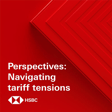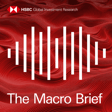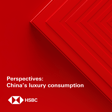Become a Creator today!Start creating today - Share your story with the world!
Start for free
00:00:00
00:00:01

Under the Banyan Tree - China tariff tensions and lessons from Japan
Fred Neumann outlines all you need to know about the US-China tariff situation, and talks to fellow economist Justin Feng about how the US-Japan trade war of the 1980s could inform how things play out. Disclaimer: https://www.research.hsbc.com/R/101/77FDmsf. Stay connected and access free to view reports and videos from HSBC Global Research follow us on LinkedIn https://www.linkedin.com/feed/hashtag/hsbcresearch/ or click here: https://www.gbm.hsbc.com/insights/global-research.
Hosted on Acast. See acast.com/privacy for more information.
Transcript
Podcast Series Introduction
00:00:02
Speaker
Welcome to HSBC Global Viewpoint, the podcast series that brings together business leaders and industry experts to explore the latest global insights, trends, and opportunities.
00:00:13
Speaker
Make sure you're subscribed to stay up to date with new episodes.
00:00:16
Speaker
Thanks for listening.
00:00:17
Speaker
And now onto today's show.
00:00:24
Speaker
This is a podcast from HSBC Global Research, available on Apple Podcasts and Spotify.
00:00:29
Speaker
However you're listening, analyst notifications, disclosures, and disclaimers must be viewed on the link attached to your media player.
US-China Tariffs Overview
00:00:45
Speaker
Hello and welcome to Under the Banyan Tree.
00:00:47
Speaker
I'm Fred Newman, chief Asia economist here in Hong Kong.
00:00:50
Speaker
There's really only one story front and center for markets and economics this week in Asia and that is, well, Mr. Donald Trump has delivered on the first batch of the China tariffs he's been promising and Beijing has hit back.
00:01:04
Speaker
I'll be giving you my thoughts on the implications of these tariffs for China and the wider Asia region.
00:01:10
Speaker
Plus, we're going to welcome my fellow economist Justin Feng to the podcast for his take on what China can learn from the trade war between the US and Japan in the 1980s.
00:01:20
Speaker
Plenty coming up on today's show from HSBC Hong Kong.
00:01:23
Speaker
You're listening to Under the Banyan Tree.
Impact of Tariffs on US and China
00:01:35
Speaker
Let's start with a quick recap of events this week.
00:01:38
Speaker
President Trump's new 10% levy on Chinese imports came into effect on Tuesday.
00:01:44
Speaker
That's in addition to the existing tariffs of up to 25% on some Chinese goods signed into law during his first term as US president.
00:01:54
Speaker
And it didn't take long for China to retaliate.
00:01:56
Speaker
This week, just hours later, Beijing announced tariffs of its own.
00:02:00
Speaker
They include an additional 10 to 15 percent levy on U.S. coal imports, crude oil and liquefied natural gas starting on February 10th, although these Chinese levies are arguably less comprehensive than the tariffs that the U.S. imposed on China.
00:02:17
Speaker
So fast moving headlines.
00:02:18
Speaker
The first thing to note is that these 10 percent tariffs on imports of goods into the United States from China applies now to all goods, whereas previously tariffs that were applied really were only targeting intermediate goods or industrial products, steel, for example, or other types of products that feed into the manufacturing process in the U.S., but not consumer goods.
00:02:42
Speaker
This time around, we suddenly see also tariffs on consumer goods.
00:02:46
Speaker
That means the average American will probably face slightly higher costs for some goods, like iPhones, for example, or other toys that are made in China.
00:02:55
Speaker
And that, of course, means that the average American will probably see a bit of an impact on their pocketbook.
00:03:02
Speaker
from these tariffs.
00:03:03
Speaker
So that's already the first thing to know.
00:03:05
Speaker
That's a difference from what we saw during the first Trump administration.
00:03:09
Speaker
Now, how important are these tariffs really for the Chinese economy?
00:03:13
Speaker
How much of a risk are they?
00:03:14
Speaker
Well, if you do some economic analysis, you could say 10% tariff
00:03:19
Speaker
all else equal, which is a term economists like to use, it is you keep all assumptions equal, would kind of shave off a few tenths of a percentage point off of China's GDP growth rates.
00:03:30
Speaker
Not nothing, but it's not the end of the world.
00:03:33
Speaker
But that's,
00:03:34
Speaker
Yeah, so there's something that China can deal with.
00:03:36
Speaker
Of course, if the tariffs rise then to from 10%, 20% to 30%, then the economic costs increase.
00:03:42
Speaker
And that's where we really start to see a much bigger drag on China's economy.
00:03:47
Speaker
But the other thing to note is that this all else equal assumption doesn't necessarily apply in the real world because partly,
00:03:54
Speaker
Chinese export prices have actually fallen since 2022, so the last two, two and a half years, by about 15 percent and much more than that of other economies.
00:04:04
Speaker
So the Chinese already have become much more competitive.
00:04:06
Speaker
So the 10 percent tariff really just puts them back a year, a year and a half or so in terms of gaining competitiveness vis-a-vis others.
00:04:14
Speaker
And that's not the end of the world.
00:04:15
Speaker
Why?
00:04:16
Speaker
Because we have
00:04:17
Speaker
We have a lot of excess capacity in China
Asian Trade Dependencies
00:04:19
Speaker
that lowered the average prices of manufactured goods.
00:04:22
Speaker
The currency was weakening as well.
00:04:24
Speaker
And so all of that actually means that maybe, maybe these 10 percent tariffs are not as big a drag on the Chinese economy.
00:04:31
Speaker
A few other points to note.
00:04:33
Speaker
Firstly, how important are actually exports overall to the Chinese economy?
00:04:37
Speaker
Well, we can use some very sophisticated trade data and analyze this.
00:04:42
Speaker
And it turns out that Chinese exports to the United States make up only about 2.5% of China's economy.
00:04:51
Speaker
This is not a huge amount.
00:04:54
Speaker
That means 97.5% of China's economy is really dependent on China.
00:04:59
Speaker
non-US market, either other export markets or domestically.
00:05:03
Speaker
And so if you lose that in one go, which is very unlikely because even with US tariffs, America is still going to buy some Chinese goods.
00:05:11
Speaker
But let's say you lose everything in one go, then you knock off 2.5% of your economy, which would hurt in the short term, but it's something you can live with in the long term.
00:05:20
Speaker
You just replace that with more consumer spending or more investment or other things.
00:05:25
Speaker
So in the long term, it's digestible.
00:05:27
Speaker
It just comes at a very awkward time cyclically for China because growth at the moment is weak.
00:05:32
Speaker
And so this just compounds the near term drag.
00:05:35
Speaker
But I think overall, the Chinese economy has in the last 20 years become far less dependent on the U.S. and far less dependent on exports in general than is widely perceived.
00:05:46
Speaker
So that's one point to note, but we should also maybe highlight that other Asian economies are much more dependent on the U.S. in terms of the GDP.
00:05:53
Speaker
So if you take Vietnam, for example, 11% of its GDP is dependent on the U.S. You get Singapore, if you include services, about 7% of its GDP.
00:06:01
Speaker
A lot of countries kind of lie in the 4% to 5% GDP range.
00:06:06
Speaker
China, as I said, just 2.5%.
00:06:08
Speaker
if tariffs were expanded on other Asian economies, that is, if the US imposed tariffs on other Asian economies, the impact on their GDP could potentially be much larger than it is on China.
00:06:19
Speaker
So this is just for context.
00:06:21
Speaker
The other thing to note is we already had trade tensions during the first Trump administration, that is, when the first Trump administration actually raised tariffs on China.
00:06:30
Speaker
What was the impact here?
00:06:32
Speaker
Well, some near-term kind of rejigging of supply chains, but ultimately it wasn't as if it kind of brought the Chinese export juggernaut to a halt.
00:06:42
Speaker
In fact, exports out of China continue to hit record highs, not necessarily to the US, but to the rest of the world, because China is just so competitive.
00:06:51
Speaker
But we did see a subtle rejigging of supply chains.
00:06:54
Speaker
That is, China moved some of its exports away from the U.S. to other markets.
00:06:58
Speaker
In fact, China's number one export market today is Southeast Asia.
00:07:02
Speaker
It isn't the U.S. It isn't Europe.
00:07:03
Speaker
It's actually Southeast Asia.
00:07:05
Speaker
And that also meant that Chinese companies moved more and more of their investment into Southeast Asia as well.
00:07:12
Speaker
integrating really the Southeast Asian economies like Vietnam, like Malaysia, like Thailand with the Chinese economy.
00:07:19
Speaker
And so in many ways, the US-China trade frictions in the first Trump term meant that China integrated its economy more with the rest of the world than was otherwise the case.
00:07:30
Speaker
And so I think that's another nuance to keep in mind here.
00:07:34
Speaker
So, when we hear these 10% tariffs, certainly quite disruptive for markets, a lot of volatility.
00:07:40
Speaker
We don't know how this case necessarily evolves.
00:07:43
Speaker
It looks likely that we could get more tariffs down the line.
00:07:46
Speaker
But I think it's sometimes important to keep some of the economic underpinnings in context here to kind of realize that ultimately the Chinese economy is going to be a little bit more.
Historical US-Japan Trade Frictions
00:07:56
Speaker
isn't as dependent on the U.S. market as it used to be, and at only 2.5% of its GDP, this is something that in the medium term would certainly be manageable for China.
00:08:07
Speaker
Now, we've plenty more to talk about, and after the break, we're going to talk to Justin Feng on his recent report on U.S.-Japan trade frictions in the 1980s and what this might imply for U.S.-China trade frictions today.
00:08:31
Speaker
Welcome, Justin Feng.
00:08:32
Speaker
Justin, thanks for joining us under the banyan tree.
00:08:35
Speaker
Thanks for having me, Fred.
00:08:36
Speaker
It's great to be here.
00:08:37
Speaker
So, Justin, you wrote a very interesting report recently looking at the lessons for China from the U.S.-Japan trade frictions in the 1980s.
00:08:48
Speaker
So, but before talking about the lessons, quickly draw a picture for us.
00:08:53
Speaker
What was actually, what kind of friction was there between the U.S. and Japan in the 1980s?
00:08:58
Speaker
Because it sounds, a lot of it sounds very familiar and what we see vis-a-vis China today.
00:09:03
Speaker
Sure, Fred.
00:09:04
Speaker
So let's go back about 60 years from now.
00:09:07
Speaker
It's in the 60s and Japan had just emerged out of World War II.
00:09:10
Speaker
Its economy was in shambles, but then it embarked on a very ambitious export-led growth miracle.
00:09:17
Speaker
And this was very successful for a very long time.
00:09:19
Speaker
But eventually, by around the 1980s, its massive trade surplus had started to lead to frictions.
00:09:25
Speaker
with the United States, which was now running a massive trade deficit against Japan.
00:09:30
Speaker
And in many industries, including autos, steel, consumer electronics, Japan started out as a bit of a technological laggard.
00:09:39
Speaker
So funny enough, nowadays we think of China as being a massive economy that makes many products, sometimes maybe not at the best quality, but certainly at tremendous volume.
00:09:50
Speaker
And actually that's what many Americans thought of Japanese exports during the 60s and 70s.
00:09:54
Speaker
It was considered a copycat electronics industry.
00:09:58
Speaker
It made many products very cheaply.
00:10:01
Speaker
But then by the 80s, many Americans have started to realize that in some of these high tech industries, Japanese companies were not only mashing their American counterparts in terms of technology, but even exceeding them in some ways.
00:10:12
Speaker
So that's a good point.
00:10:13
Speaker
In fact, semiconductors come into play here, right?
00:10:16
Speaker
The US invented semiconductors.
00:10:18
Speaker
It was leading in the 1970s.
00:10:21
Speaker
But what then happened in the 1980s when it came to semiconductors?
00:10:24
Speaker
Right.
00:10:24
Speaker
So during the 1980s, as you said, Americans, they invented the integrated circuit, the semiconductor.
00:10:30
Speaker
But then Japanese electronics firms such as Sony and other firms started out by copying how to make semiconductors from American companies.
00:10:38
Speaker
But then they themselves were then able to replicate and then innovate on top of those technologies.
00:10:44
Speaker
And by the 80s, in certain segments of the chip industry, for example, memory chips, Japan actually accounted for 50 percent
00:10:50
Speaker
of the global market, which was tremendous because considering they just started from zero a couple of decades before that.
00:10:56
Speaker
So we have here a picture of early 1980s.
00:10:59
Speaker
Japan becomes a big exporter.
00:11:03
Speaker
It's flooding the U.S. market with cars, with steel, with semiconductors.
00:11:08
Speaker
It's threatening U.S. companies.
00:11:11
Speaker
It's threatening American jobs in many ways.
00:11:13
Speaker
And so that's reminiscent of China.
00:11:16
Speaker
the friction with China today, which has become an economic powerhouse.
00:11:20
Speaker
Now, in the 1980s, the Reagan administration, Ronald Reagan, the US president, what did the US do in order to kind of rein in Japan's competitive threat?
00:11:30
Speaker
Right, sure.
00:11:30
Speaker
So in many ways, the Reagan administration actually
00:11:32
Speaker
It took many measures that might seem very similar to what we now see with the Trump administration, of course, with a very different style of rhetoric.
00:11:40
Speaker
But in terms of the pressure, right, the trade restrictions, the threat of tariffs, and in fact, the utilization of tariffs during the late 1980s, the U.S. used a host of measures to pressure Japan, which then eventually used what we call voluntary export restraints, or VERs,
00:11:57
Speaker
So they self-restrained their own exports towards the U.S. under the threat of U.S. tariffs.
00:12:03
Speaker
And the U.S. also used monetary policy realignment to appreciate the Japanese yen.
00:12:09
Speaker
Monetary policy alignment, let's put it aside and come back to that briefly.
00:12:12
Speaker
But it's interesting that rather than necessarily accept these tariffs, Japan, what you said was...
00:12:20
Speaker
imposing voluntary export restraints with saying, okay, we understand you have a problem with our exports.
00:12:27
Speaker
We're going to reduce our exports to the US market, but we're going to invest in the US instead.
00:12:34
Speaker
We're going to actually move foreign direct investment into the United States.
00:12:38
Speaker
Talk a little bit about that.
00:12:39
Speaker
What was the foreign direct investment implication?
00:12:41
Speaker
Sure.
00:12:42
Speaker
This is most prominent in the auto industry, right?
00:12:45
Speaker
Because the auto industry was one of the biggest targets of the Reagan administration's trade policies.
00:12:49
Speaker
The U.S. also invented the automobile, of course.
00:12:52
Speaker
And it was the, you know, concern the pride of the American manufacturing industry, the fact that Americans were able to make their own cars and were very successful for many decades.
00:13:00
Speaker
But then you had...
00:13:01
Speaker
the more fuel-efficient Japanese cars that entered the market, and especially considering, of course, the oil crisis at that time, you know, fuel efficiency became very important.
00:13:11
Speaker
And because of Japanese competitiveness, many U.S. auto plants had to close down.
00:13:16
Speaker
So to kind of alleviate this political pressure, many Japanese auto firms then set up their own production plants within the U.S. throughout the 80s,
00:13:26
Speaker
And even to this day, we think about many Japanese auto companies, actually, they have become incredibly localized within the U.S. You go to any Toyota or Honda dealership in the U.S., and there's a good chance that that car was produced entirely within the United States.
00:13:42
Speaker
So one of the implications was foreign direct investment actually increased as a result of these terror frictions.
00:13:49
Speaker
In Japan's case, more foreign direct investment by Japanese companies in the U.S. In China's case, actually, we saw an increase in foreign direct investment as well.
00:13:57
Speaker
as a result of the trade frictions with the US.
00:14:00
Speaker
But Chinese companies, of course, investing more elsewhere in the world, particularly Southeast Asia, particularly Europe, other emerging markets.
00:14:07
Speaker
So there's some parallels there.
00:14:09
Speaker
But you mentioned something that is a monetary policy realignment.
00:14:12
Speaker
Big words here.
00:14:13
Speaker
But essentially what this meant was this Plaza Accord, which was Plaza being a hotel in New York City, owned famously by Donald Trump at some point, not at the point
00:14:26
Speaker
in early 1980s, but a little bit later.
00:14:29
Speaker
But regardless, at this hotel, monetary officials, central bankers from Japan, the US, Germany met and actually hashed out a deal, the Plaza Accord, that led to weakening of the US dollar
00:14:46
Speaker
and a strengthening of the Japanese yen, in part to address the extraordinary competitiveness of Japanese companies, because the Americans said the Japanese yen is too weak, too competitive, so let's realign it.
00:14:58
Speaker
And that actually worked quite well in the sense of realigning currencies.
00:15:02
Speaker
Absolutely.
00:15:03
Speaker
And in many ways, it did have an effect on Japanese exports.
00:15:08
Speaker
But also, of course, then later in part led to an asset bubble in Japan and then the subsequent collapse.
00:15:14
Speaker
So it also had big ramifications on Japan's internal economy, not just its external exports.
00:15:20
Speaker
Why was it?
00:15:21
Speaker
Why would a currency realignment lead to an asset bubble in Japan?
00:15:25
Speaker
Sure.
00:15:25
Speaker
I mean, its currency appreciated very rapidly.
00:15:27
Speaker
And then, of course, its central bank moved very quickly there afterwards.
00:15:31
Speaker
But, you know, in many ways as well, this is also Japan itself.
00:15:36
Speaker
Its own economies, of course, was having structural issues as well, right?
00:15:40
Speaker
And, of course, we also have to think about its competitors.
00:15:42
Speaker
At that time, many other Asian economies, such as South Korea and Taiwan, were also rapidly industrializing.
00:15:48
Speaker
And that also affected Japan's export competitiveness.
00:15:51
Speaker
So, in many ways, yeah.
00:15:52
Speaker
So, Japan's export competitiveness was affected by the currency realignment.
00:15:56
Speaker
The central bank in Japan responds then to weaker growth by cutting interest rates, fueling an asset bubble in Japan, which was famously one of the biggest asset bubbles that we know in history.
00:16:08
Speaker
And that ultimately, that collapse of that asset bubble then caused Japan's multi-decade growth problems.
00:16:14
Speaker
There are a lot of nuances here, but that's in a nutshell what happened.
00:16:18
Speaker
That's why
00:16:19
Speaker
Japan's economic history over the last 30, 40 years relates directly to the trade frictions with the US in the 1980s.
00:16:26
Speaker
And we can trace through the consequences here.
00:16:28
Speaker
Now, there is something interesting though here for China, and that is the Chinese will have watched the Japanese experience
US-China Currency Agreement Discussion
00:16:36
Speaker
quite closely.
00:16:36
Speaker
And we read a lot about this idea that China's currency is undervalued from the perspective of the US.
00:16:42
Speaker
Do you think, based on what you've looked at, Japan, for example, that it's quite likely we could get a big currency deal between China and the U.S., where the U.S. says you should appreciate your currency, make it less competitive, and suddenly the Chinese currency, like the Japanese currency, actually rises in value to reduce the competitiveness of Chinese exports?
00:17:05
Speaker
Do you think such a deal is likely?
00:17:07
Speaker
I don't know how we would call it.
00:17:08
Speaker
A plaza accord, probably not.
00:17:10
Speaker
Maybe a Mar-a-Lago accord.
00:17:11
Speaker
A Mar-a-Lago accord.
00:17:12
Speaker
There you go.
00:17:13
Speaker
Well, there certainly have been some growing voices within the domestic Chinese media and commentary landscape that have maybe even predicting a slight appreciation of the RMB.
00:17:23
Speaker
But our view actually is that we will likely not see this type of major currency agreement for a variety of reasons, one of which is, well, of course, the FX market has...
00:17:34
Speaker
changed quite a bit since 1985.
00:17:35
Speaker
It's grown enormously in scale and sophistication.
00:17:40
Speaker
So such a deal would be enormously, exorbitantly expensive.
00:17:44
Speaker
Of course, there's also economic fundamentals to keep in mind, right?
00:17:47
Speaker
It takes more than a central bank intervention nowadays to reverse a course of direction.
00:17:53
Speaker
And also, of course, China is not Japan, right?
00:17:55
Speaker
China today is very different from Japan in the 80s.
00:17:58
Speaker
We believe in terms of trade, it has a much stronger hand.
00:18:02
Speaker
And of course, there's also geopolitical implications to keep in mind.
00:18:05
Speaker
And also, I think the Chinese will probably look at Japan's asset bubble and do not want to necessarily repeat that.
00:18:11
Speaker
And that's probably a reason not to allow the currency to inflate too much because it might actually prompt an asset bubble that then has longer term consequences.
00:18:21
Speaker
And I think that's also something Chinese officials certainly may have studied and concluded that maybe dramatic currency
00:18:27
Speaker
appreciation is on the cards, although of course our FX strategists still argue that that wouldn't necessarily preclude a slight weakening, for example, of the currency over the coming year or
Conclusion and Future Topics
00:18:40
Speaker
so.
00:18:40
Speaker
Justin, there's tons here to unpack and tons to watch, and I'm sure with the US administration moving as fast as it has, we're going to need to revisit this issue.
00:18:51
Speaker
So thanks a lot for coming into the studio and talking to us here on The Banyan Tree.
00:18:55
Speaker
Thanks for having me.
00:18:55
Speaker
It's a pleasure to be here.
00:18:57
Speaker
We're going to leave it here, ladies and gents.
00:18:59
Speaker
Thanks as ever for joining us under the Banyan Tree.
00:19:01
Speaker
We will, of course, keep across this story for quite some time.
00:19:04
Speaker
In the meantime, listen, like, and subscribe to our sister podcast, The Macro Brief.
00:19:09
Speaker
This week's episode takes a global view on Trump's tariffs and even includes a little cameo from yours truly.
00:19:15
Speaker
We'll be back again next week putting Asian markets and economics in context.
00:19:19
Speaker
Talk to you then.
00:19:48
Speaker
Thank you for joining us at HSBC Global Viewpoint.
00:19:51
Speaker
We hope you enjoyed the discussion.
00:19:53
Speaker
Make sure you're subscribed to stay up to date with new episodes.
















